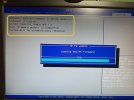britechguy
Well-Known Member
- Reaction score
- 5,075
- Location
- Staunton, VA
. . . the machine I have in my hands now is exactly why I do.
An old HP EliteBook 8560P with an i5 2nd gen in it. Started out life with Windows 7, but was upgraded to Windows 10.
The BIOS/UEFI that was still on board was Version F22 dating from 2011. The latest version from HP for this machine, which I've manually downloaded and installed, is F67 from 2018.
If HP supplies such updates for Windows Update to apply, it would be better if it did. I know that end users are not going to do it.
An old HP EliteBook 8560P with an i5 2nd gen in it. Started out life with Windows 7, but was upgraded to Windows 10.
The BIOS/UEFI that was still on board was Version F22 dating from 2011. The latest version from HP for this machine, which I've manually downloaded and installed, is F67 from 2018.
If HP supplies such updates for Windows Update to apply, it would be better if it did. I know that end users are not going to do it.

